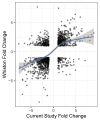Transcriptional Analysis of Coccidioides immitis Mycelia and Spherules by RNA Sequencing
- PMID: 34067070
- PMCID: PMC8150946
- DOI: 10.3390/jof7050366
Transcriptional Analysis of Coccidioides immitis Mycelia and Spherules by RNA Sequencing
Abstract
Coccidioides immitis and C. posadasii are dimorphic fungi that transform from mycelia with internal arthroconidia in the soil to a tissue form known as a spherule in mammals. This process can be recapitulated in vitro by increasing the temperature, CO2 and changing other culture conditions. In this study, we have analyzed changes in gene expression in mycelia and young and mature spherules. Genes that were highly upregulated in young spherules include a spherule surface protein and iron and copper membrane transporters. Genes that are unique to Coccidioides spp. are also overrepresented in this group, suggesting that they may be important for spherule differentiation. Enriched GO terms in young spherule upregulated genes include oxidation-reduction, response to stress and membrane proteins. Downregulated genes are enriched for transcription factors, especially helix-loop-helix and C2H2 type zinc finger domain-containing proteins, which is consistent with the dramatic change in transcriptional profile. Almost all genes that are upregulated in young spherules remain upregulated in mature spherules, but a small number of genes are differentially expressed in those two stages of spherule development. Mature spherules express more Hsp31 and amylase and less tyrosinase than young spherules. Some expression of transposons was detected and most of the differentially expressed transposons were upregulated in spherules.
Keywords: Coccidioides immitis; RNA-Seq; coccidioidomycosis; differential gene expression; differentiation; dimorphic fungus; fungus; mycelium; spherule.
Conflict of interest statement
The authors declare no conflict of interest.
Figures





Similar articles
-
Coccidioides Species: A Review of Basic Research: 2022.J Fungi (Basel). 2022 Aug 16;8(8):859. doi: 10.3390/jof8080859. J Fungi (Basel). 2022. PMID: 36012847 Free PMC article. Review.
-
Gene expression in human fungal pathogen Coccidioides immitis changes as arthroconidia differentiate into spherules and mature.BMC Microbiol. 2013 May 28;13:121. doi: 10.1186/1471-2180-13-121. BMC Microbiol. 2013. PMID: 23714098 Free PMC article.
-
The WOPR family protein Ryp1 is a key regulator of gene expression, development, and virulence in the thermally dimorphic fungal pathogen Coccidioides posadasii.PLoS Pathog. 2022 Apr 6;18(4):e1009832. doi: 10.1371/journal.ppat.1009832. eCollection 2022 Apr. PLoS Pathog. 2022. PMID: 35385558 Free PMC article.
-
Life Cycle Dominates the Volatilome Character of Dimorphic Fungus Coccidioides spp.mSphere. 2021 Apr 14;6(2):e00040-21. doi: 10.1128/mSphere.00040-21. mSphere. 2021. PMID: 33853870 Free PMC article.
-
Arthroconidia in coccidioidoma: case report and literature review.Int J Infect Dis. 1998 Jul-Sep;3(1):32-5. doi: 10.1016/s1201-9712(98)90092-3. Int J Infect Dis. 1998. PMID: 9831673 Review.
Cited by
-
Evaluation of Different Gene Prediction Tools in Coccidioides immitis.J Fungi (Basel). 2023 Nov 9;9(11):1094. doi: 10.3390/jof9111094. J Fungi (Basel). 2023. PMID: 37998899 Free PMC article.
-
Transcriptomic atlas throughout Coccidioides development reveals key phase-enriched transcripts of this important fungal pathogen.PLoS Biol. 2025 Apr 15;23(4):e3003066. doi: 10.1371/journal.pbio.3003066. eCollection 2025 Apr. PLoS Biol. 2025. PMID: 40233121 Free PMC article.
-
Genome Organization and Copy-Number Variation Reveal Clues to Virulence Evolution in Coccidioides posadasii.J Fungi (Basel). 2022 Nov 22;8(12):1235. doi: 10.3390/jof8121235. J Fungi (Basel). 2022. PMID: 36547568 Free PMC article.
-
Coccidioides Species: A Review of Basic Research: 2022.J Fungi (Basel). 2022 Aug 16;8(8):859. doi: 10.3390/jof8080859. J Fungi (Basel). 2022. PMID: 36012847 Free PMC article. Review.
-
Non-dikarya fungi share the TORC1 pathway with animals, not with Saccharomyces cerevisiae.Sci Rep. 2025 Feb 18;15(1):5926. doi: 10.1038/s41598-025-89635-4. Sci Rep. 2025. PMID: 39966606 Free PMC article.
References
-
- Engelthaler D.M., Roe C.C., Hepp C.M., Teixeira M., Driebe E.M., Schupp J.M., Gade L., Waddell V., Komatsu K., Arathoon E., et al. Local Population Structure and Patterns of Western Hemisphere Dispersal for Coccidioides spp., the Fungal Cause of Valley Fever. MBio. 2016;7:e00550-16. doi: 10.1128/mBio.00550-16. - DOI - PMC - PubMed
-
- Nguyen C., Barker B.M., Hoover S., Nix D.E., Ampel N.M., Frelinger J.A., Orbach M.J., Galgiani J.N. Recent advances in our understanding of the environmental, epidemiological, immunological, and clinical dimensions of coccidioidomycosis. Clin. Microbiol. Rev. 2013;26:505–525. doi: 10.1128/CMR.00005-13. - DOI - PMC - PubMed
Grants and funding
LinkOut - more resources
Full Text Sources
Molecular Biology Databases
Miscellaneous

